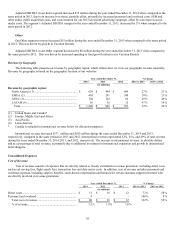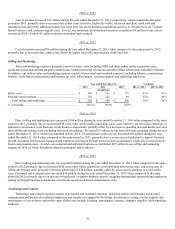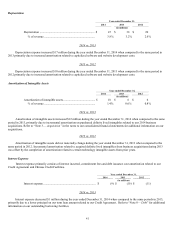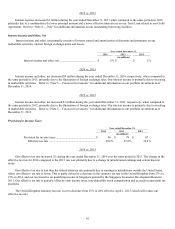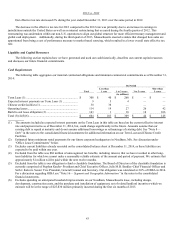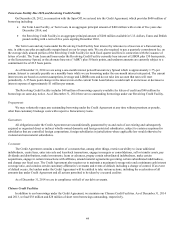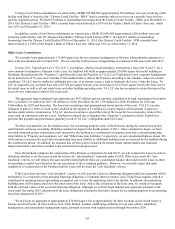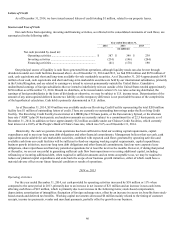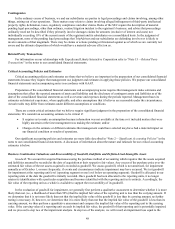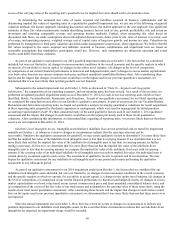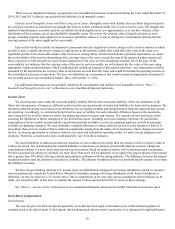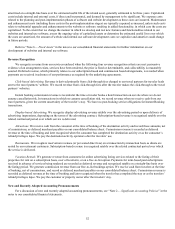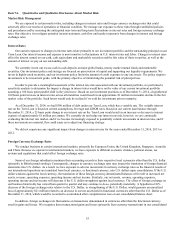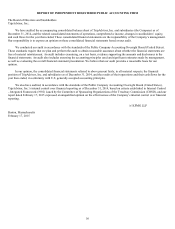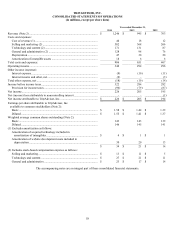TripAdvisor 2014 Annual Report Download - page 58
Download and view the complete annual report
Please find page 58 of the 2014 TripAdvisor annual report below. You can navigate through the pages in the report by either clicking on the pages listed below, or by using the keyword search tool below to find specific information within the annual report.48
Contingencies
In the ordinary course of business, we and our subsidiaries are parties to legal proceedings and claims involving, among other
things, arising out of our operations. These matters may relate to claims involving alleged infringement of third-party intellectual
property rights, defamation, taxes, regulatory compliance and other claims. Rules of the SEC require the description of material
pending legal proceedings, other than ordinary, routine litigation incident to the registrant’s business, and advise that proceedings
ordinarily need not be described if they primarily involve damages claims for amounts (exclusive of interest and costs) not
individually exceeding 10% of the current assets of the registrant and its subsidiaries on a consolidated basis. In the judgment of
management, none of the pending legal proceedings that TripAdvisor and our subsidiaries are defending involves or is likely to
involve amounts of that magnitude. There may be claims or actions pending or threatened against us of which we are currently not
aware and the ultimate disposition of which would have a material adverse effect on us.
Related Party Transactions
For information on our relationships with Expedia and Liberty Interactive Corporation refer to “Note 15 —Related Party
Transactions” in the notes to our consolidated financial statements.
Critical Accounting Policies and Estimates
Critical accounting policies and estimates are those that we believe are important in the preparation of our consolidated financial
statements because they require that management use judgment and estimates in applying those policies. We prepare our consolidated
financial statements and accompanying notes in accordance with GAAP.
Preparation of the consolidated financial statements and accompanying notes requires that management make estimates and
assumptions that affect the reported amounts of assets and liabilities and the disclosure of contingent assets and liabilities as of the
date of the consolidated financial statements as well as revenue and expenses during the periods reported. Management bases its
estimates on historical experience, where applicable, and other assumptions that it believes are reasonable under the circumstances.
Actual results may differ from estimates under different assumptions or conditions.
There are certain critical estimates that we believe require significant judgment in the preparation of the consolidated financial
statements. We consider an accounting estimate to be critical if:
x It requires us to make an assumption because information was not available at the time or it included matters that were
highly uncertain at the time management was making the estimate; and/or
x Changes in the estimate or different estimates that management could have selected may have had a material impact on
our financial condition or results of operations.
Our significant accounting policies and estimates are more fully described in “Note 2— Significant Accounting Policies” in the
notes to our consolidated financial statements. A discussion of information about the nature and rationale for our critical accounting
estimates is below.
Business Combination Valuations and Recoverability of Goodwill, Indefinite and Definite-Lived Intangible Assets
Goodwill. We account for acquired businesses using the purchase method of accounting which requires that the assets acquired
and liabilities assumed be recorded at the date of acquisition at their respective fair values. Any excess of the purchase price over the
estimated fair values of the net assets acquired is recorded as goodwill. We assess goodwill, which is not amortized, for impairment
annually as of October 1, or more frequently, if events and circumstances indicate impairment may have occurred. We test goodwill
for impairment at the reporting unit level (operating segment or one level below an operating segment). Goodwill is allocated to our
reporting units at the date the goodwill is initially recorded. Once goodwill has been allocated to the reporting units, it no longer
retains its identification with a particular acquisition and becomes identified with the reporting unit in its entirety. Accordingly, the
fair value of the reporting unit as a whole is available to support the recoverability of its goodwill.
In the evaluation of goodwill for impairment, we generally first perform a qualitative assessment to determine whether it is more
likely than not (i.e., a likelihood of more than 50%) that the implied fair value of the reporting unit is less than the carrying amount. If
we determine that it is not more likely than not that the implied fair value of the goodwill is less than its carrying amount, no further
testing is necessary. If, however, we determine that it is more likely than not that the implied fair value of the goodwill is less than its
carrying amount, we then perform a quantitative assessment and compare the implied fair value of the reporting unit to the carrying
value. If the carrying value of a reporting unit exceeds its implied fair value, the goodwill of that reporting unit is potentially impaired
and we proceed to step two of the impairment analysis. In step two of the analysis, we will record an impairment loss equal to the


